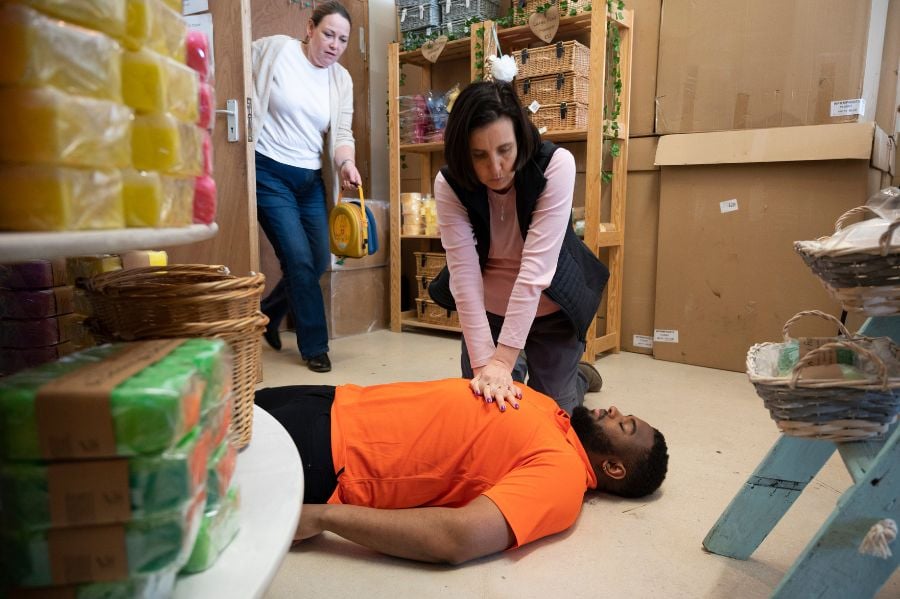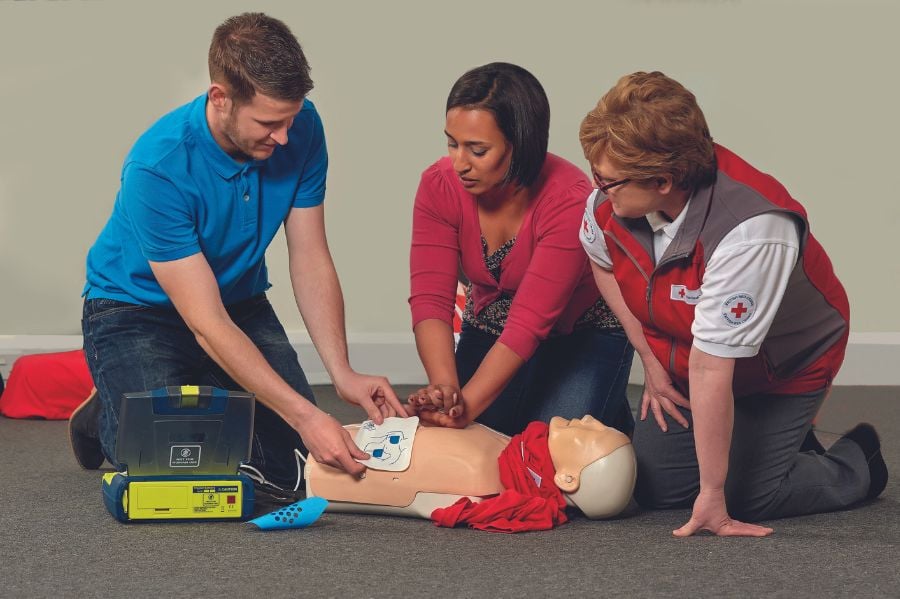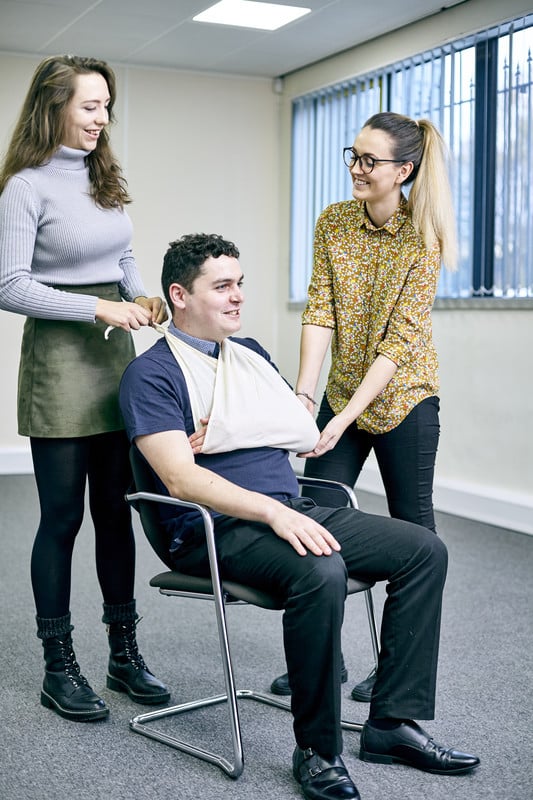This National Heart Month, we’re highlighting how defibrillators are crucial in the workplace, the legal requirements for employers and how and when you’d need to use one.
If someone is unresponsive and not breathing, their heart has stopped working (they are in cardiac arrest) and time is critical.
What is an AED?
An AED (Automated External Defibrillator) is used to help someone who is in cardiac arrest (unresponsive and not breathing). It's a sophisticated yet easy-to-use medical device that, through pads applied to the chest, can analyse the heart's rhythm and, if necessary, deliver an electrical shock to the heart.
Why are defibrillators important in the workplace?
Quick use of an Automated External Defibrillator (AED) can lead to survival rates of 50% to 70%* and if someone is unresponsive and not breathing, defibrillators are crucial, as every minute that passes without chest compressions and defibrillation reduces their chance of survival by up to 10%.
The quicker an unresponsive person who is not breathing can receive chest compressions and a shock from an AED, the greater their chance of survival.
The chain of survival
- Early recognition and call for help
It is important to recognise those at risk of a cardiac arrest and call for help quickly.
- Early Cardio Pulmonary Resuscitation (CPR)
If they are unresponsive and not breathing normally then giving chest compressions and rescue breaths promptly ‘buys time’ by keeping the person’s blood circulating, while waiting for expert help to arrive.
- Early defibrillation
An AED delivers a controlled electric shock to the person’s heart which may restart it; this is called defibrillation.
- Post resuscitation care
Specialist treatment by ambulance and hospital staff can stabilise the casualty and give them the best chance of survival.
Does every workplace need have to have a defibrillator?
The Health and Safety (First-Aid) Regulations 1981 require employers to provide “adequate and appropriate” equipment, facilities and personnel to ensure that employees receive immediate attention “in the event of injury or sudden illness at work”.
Even though defibrillators are crucial, the decision whether an employer needs to provide an AED, and training for their staff on how to use it, will depend on the outcome of the first aid needs assessment.
While there is no specific legal requirement for employers to provide AEDs in the workplace, in many modern working environments, AEDs are often being added to a company’s first aid provision on site.
As a minimum requirement, where an employer has identified through their needs assessment that they wish to provide an AED in the workplace, then the Provision and Use of Workplace Equipment Regulations 1998 (PUWER) apply. For compliance with PUWER in these situations, the employer should provide information and written instructions on how to use it.
Where should a defibrillator be placed in the workplace?
AEDs should be:
- Centrally located within high-risk areas.
- Highly visible (cabinets can help deter theft and help with visibility).
- Near a phone to call 999.
- Easily accessible (they should be located 48 inches above the floor to ensure everyone can access it, even those who are in wheelchairs).
- Clearly marked and sign posted.
As well as being highly visible and accessible, you’ll want to be able to respond quickly and clearly when someone shouts “Where is the AED?”. Examples could include: “In reception by the front desk,” “next to the lift” or “at the bottom of the stairs.”
If you’re unsure where your nearest AED is, ask your organisation’s health and safety officer, facilities manager or equivalent.
How many defibrillators should be in a building?
The number you need depends on a range of factors. Defibrillators are crucial in a first aid emergency, so you should think about how long it would take to get a defibrillator. Ideally it should take no longer than two minutes to get it and two minutes to get back. If members of you team have accessibility issues, you’ll need to ensure that the defibrillator is easy to access. You should also consider:
- number of sites
- number of people based at/passing through each site
- number of floors in a building
- size of floors in a building.
Do defibrillators need to be maintained?
Defibrillators are crucial in the workplace and need to be maintained, even if the defibrillator hasn’t been used. The pads and batteries have a typical shelf life of between two and five years, depending on the model. You should check the user manual or supplier’s website for help with shelf life and replacement requests.
As workplaces may be quieter, are there first aiders who can respond quickly?
Both hybrid working and lone working can have significant impacts on first aid provision. The availability of first aiders can be managed by employers by training additional first aiders and operating a rota system for hybrid working to ensure sufficient numbers of first aiders are onsite at all times. Our blog on how many first aiders are required for a workplace can help you get this right and take into account other factors such as employee absence, shift working and breaks during the working day.
When should you use an AED?
In a cardiac arrest, a person’s heart stops pumping blood around their body and vitally, this means the brain may not be getting enough oxygen to survive. The person will not respond to you or be breathing normally when you tilt their head back and check.
It’s important to start chest compressions and rescue breaths as quickly as possible because a person’s brain and other vital organs cannot survive for long without a supply of oxygen.
We recommend the following steps on how to help when someone is unresponsive and not breathing:
1. Call 999 and ask someone to get the AED.
2. Give 30 chest compressions: push firmly downwards in the middle of the chest and then release.
3. Give two rescue breaths: tilt their head back, pinch their nose, seal your mouth over their mouth and blow steadily.
4. Continue with cycles of 30 chest compressions and 2 rescue breaths, until help arrives.
5. When the AED arrives, open the AED, turn it on and follow its voice prompts.

How to use an AED?
AED instructions are straightforward so that even a person who has never seen an AED before can use one. While different brands of AEDS will vary in design and how they look, the method of using an AED is universally the same.
The AED voice prompts should be followed by one helper, while someone else continues doing the cycles of chest compressions and rescue breaths, as explained above.
However, we know it can be daunting if you’ve never had to use one before. That’s why our first aid training courses, such as First Aid at Work courses include practical training on how to use an AED. Our interactive courses provide the practical skills and confidence to help save lives.
Topics: First Aid



